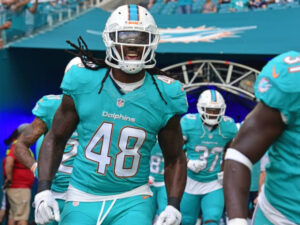Shock Waves in Miami: Dolphins’ Unexpected Roster Cuts Leave Fans Reeling
In a surprising turn of events, the Miami Dolphins have sent shockwaves through the NFL community by releasing seven players from their roster, a decision that has left fans and analysts alike questioning the team’s strategy. Among the most notable moves, safeties Terrell Burgess and Dee Delaney have been placed on injured reserve (IR), a development that has further fueled speculation about the Dolphins’ plans for the upcoming season.
The decision to part ways with these players comes as the Dolphins prepare to make final adjustments ahead of the regular season. The cuts, which include both veterans and younger talents, have sparked intense debate among the fanbase, many of whom are now questioning the team’s depth and readiness for the challenges ahead. While roster adjustments are a common practice in the NFL, the release of seven players in one go has raised eyebrows, especially given the timing just before the start of the season.
The placement of Burgess and Delaney on IR adds another layer of complexity to the Dolphins’ defensive lineup. Both players were expected to contribute significantly this season, and their absence will undoubtedly leave gaps that the coaching staff will need to address quickly. The decision to place them on IR has led to further concerns about the team’s ability to maintain a strong defensive presence on the field.
As fans grapple with the implications of these roster changes, the Dolphins’ management remains tight-lipped about the long-term strategy behind these moves. With the season opener just around the corner, all eyes will be on Miami to see how the team adapts to these sudden changes and whether they can overcome the challenges that lie ahead.

Cutting seven players from an NFL roster is typically part of a team’s strategy to fine-tune their lineup before the regular season. Several factors can drive such a decision:
1. **Roster Limits:** The NFL imposes strict limits on the number of players a team can carry, especially as the regular season approaches. Teams often need to reduce their roster size from a larger preseason roster to the final 53-man squad, leading to player cuts.
2. **Performance Evaluation:** Preseason games and training camps are critical periods where players are evaluated. If a player doesn’t meet performance expectations or fit into the team’s scheme, they may be released.
3. **Injuries:** Injured players, like Terrell Burgess and Dee Delaney, can be placed on Injured Reserve (IR), freeing up roster spots for healthier players. This allows the team to retain talent while still meeting roster limits.
4. **Depth Chart Adjustments:** Teams constantly assess their depth charts to ensure they have the right balance of talent at each position. If certain positions are overstocked, some players may be cut to make room for more critical needs.
5. **Salary Cap Considerations:** The NFL’s salary cap forces teams to make tough financial decisions. Cutting players can sometimes be a way to manage cap space, particularly if a player’s contract is seen as too costly relative to their expected contribution.
In summary, cutting seven players is part of a broader strategy to ensure the team is optimized for the season, balancing performance, health, and financial considerations.